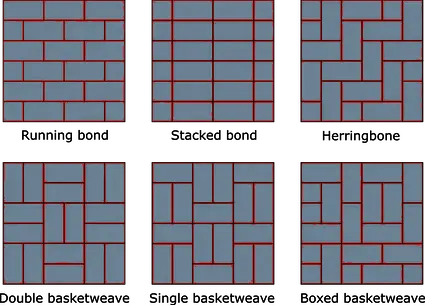Concrete Paver Calculator


John is planning to have his patio paved with bricks. Here's how he calculates the number of pavers he needs:
John's patio is shaped like a five-point star. He decides to divide it into 5 smaller square areas, each measuring 12' × 12'. Using the formula:
patio area = subarea width × subarea length × number of subareas
For his patio, the calculation looks like this:
patio area = 12 ft × 12 ft × 5 = 720 ft²
John decides to use square pavers that are 8" × 8". To find the area of a single paver, we multiply its length by its width:
area of a single paver = 8 in × 8 in = 64 in²
Next, he needs to figure out how many pavers fit into one square foot. Since there are 144 square inches in one square foot, the number of pavers per square foot is calculated like this:
pavers per square foot = 144 / single brick's area
For John’s pavers, the calculation is:
pavers per square foot = 144 / 64 = 2.25
Since you can't use a fraction of a paver, John will round up, so he needs 3 pavers per square foot.
Now, John multiplies the number of pavers per square foot by the total patio area to get the total number of pavers required:
total number of pavers = pavers per square foot × patio area
So, the total number of pavers is:
total number of pavers = 3 × 720 = 2,160
John has found pavers that cost $0.60 each. To estimate the total cost of the pavers, he multiplies the number of pavers by the cost per paver:
paver cost = 2,160 × $0.60 = $1,296
In addition, John wants to hire a professional to install the pavers. The installation cost in his area is $10 per square foot, so the total installation cost is:
installation cost = patio area × cost per square foot
For John’s patio, the installation cost is:
installation cost = 720 × $10 = $7,200
The Running Bond pattern is one of the most common and natural paving patterns, typically associated with simple brickwork. It's easy to create and gives a clean, timeless look. This pattern works best when using rectangular bricks but can also be adapted for square bricks. The bricks are laid in rows with each row offset by half the length of the brick.
The Stacked Bond pattern is one of the simplest to create, although it is not commonly used for pavers. It involves stacking the pavers directly on top of each other in rows. This pattern is ideal if you're working on a DIY paving project due to its simplicity. However, it may not be as durable as other patterns, especially for high-traffic areas.
The Herringbone pattern is one of the most dynamic and attractive choices. It is characterized by a V-shaped weaving pattern and is often used at a 90° angle. However, it is equally popular to lay the pavers at a 45° angle for a different effect. This pattern provides excellent stability, making it ideal for areas with heavy foot traffic. It is also commonly used for driveways and walkways.
The Basketweave pattern creates the illusion of long bricks disappearing under each other, much like the weave of a real basket. This pattern is quite versatile and can be customized with various combinations of brick orientations. It's often used in decorative patios, pathways, and garden areas. You can find many variations of the basketweave pattern, depending on how the pavers are arranged.
In addition to these popular patterns, there are plenty of other designs you can experiment with, such as the Chevron, Parquet, and Circular patterns. Each pattern offers a unique aesthetic and can be tailored to suit your specific design preferences and space requirements.